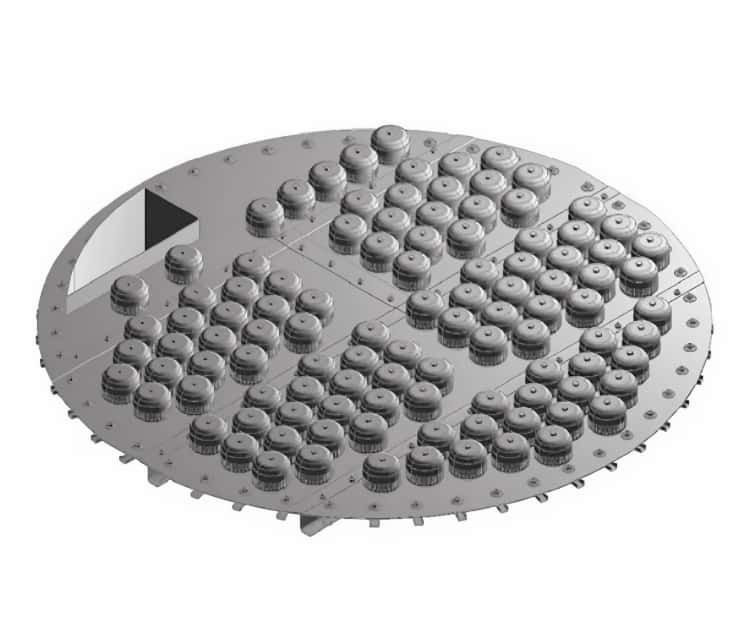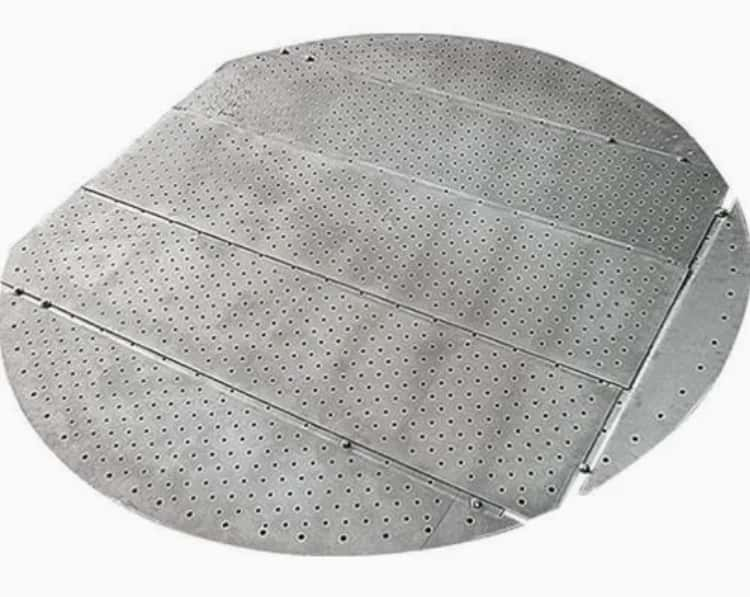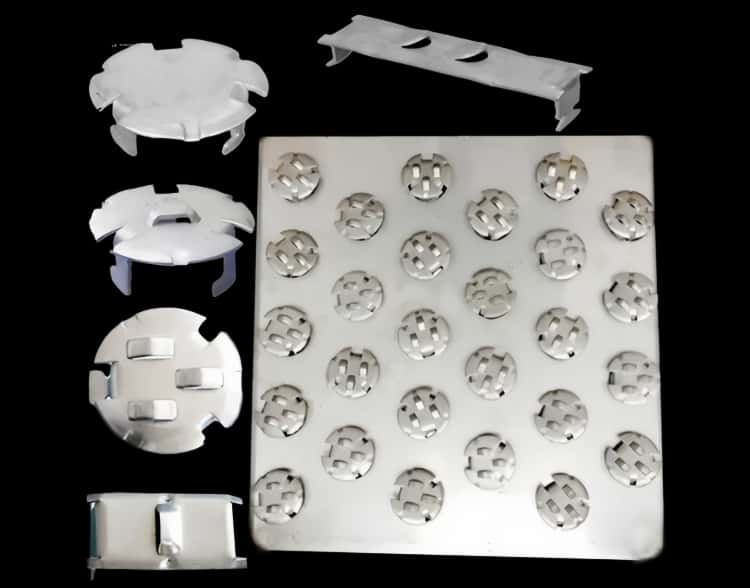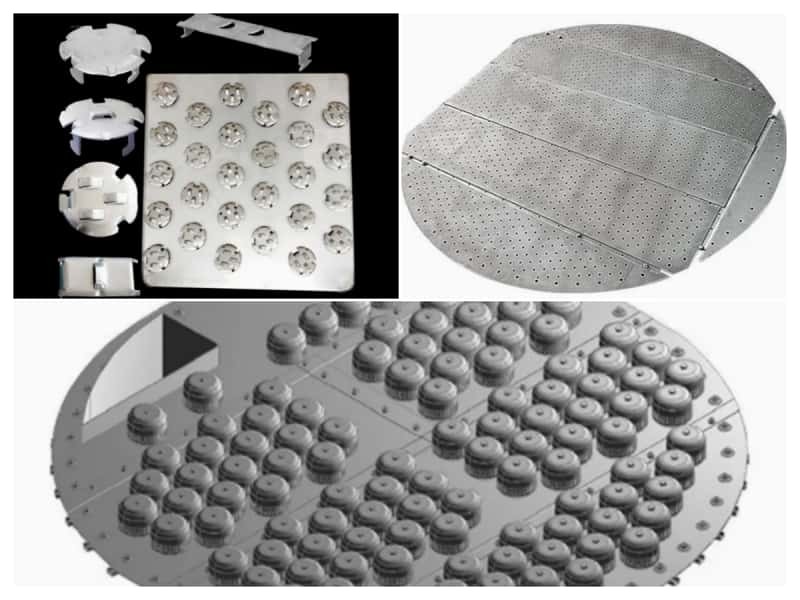Distillation columns are essential in industries such as petrochemicals, pharmaceuticals, and chemicals for separating liquid mixtures based on differences in volatility. The efficiency of a distillation column depends on its internal components, which facilitate vapor-liquid contact. The two primary types of internals distillation column trays and packing.Industrial distillation columns utilize trays or packing materials to facilitate vapor-liquid contact, thereby separating components of liquid mixtures to achieve desired purities. Approximately half of the distillation columns worldwide are equipped with trays, while the other half use packing materials. This article provides a brief review of the differences between these two options and their suitability for various process applications
Distillation Column Trays: Types and Features
Trays are horizontal plates stacked inside a distillation column. They support liquid flow while allowing vapor to pass through, enabling the separation of components. Each tray contributes to the overall purity of the separated substances.
1. Bubble Cap Trays
In the bubble caps tray design, vapors rise through risers or chimneys into a cap, then exit through slots or holes in the cap and bubble through the surrounding liquid on the tray. This ensures total contact between vapors and liquid for effective mixing and mass transfer. The liquid flows over the caps on the tray from the upper downcomer to the outlet weir and downcomer to the tray below. An outlet weir near the downcomer maintains a liquid head on the tray.

How They Work: Vapor rises through chimneys into a cap and exits through slots, bubbling through the liquid. Liquid flows over the caps and moves to the next tray via downcomers.
Advantages: Excellent vapor-liquid mixing, minimal weeping, and a built-in seal to prevent liquid drainage at low vapor flow rates.
Disadvantages: High-pressure drop, higher cost, and requires more space and materials for manufacturing.
2. Sieve Trays
The sieve plate is the simplest type of cross-flow plate. It has small round holes (perforations, typically ⅛ to 1 in.) punched on the tray deck. Vapor rises through these small perforations on the tray floor and bubbles through the liquid in a fairly uniform manner. The liquid then flows across the tray floor over the weir, through the downcomer to the tray below.

Advantages of Sieve Trays
1. Simple and Cost-Effective: Sieve trays are simpler in design and lower in cost compared to bubble cap and valve-type trays.
2. Easy Operation and Maintenance: They are easy to operate, maintain, and clean.
3. Lower Pressure Drop: The pressure drop across sieve trays is lower compared to other tray types.
Disadvantages of Sieve Trays
1. Poor Performance at Low Flow Rates: There is no positive vapor-liquid seal, and at low flow rates, liquid can “weep” through the holes, reducing tray efficiency.
2. Higher Froth Heights: The vertically exiting vapors in sieve trays create higher froth heights, increasing the potential for liquid entrainment.
3. Valve Trays
The openings in valve trays are covered with liftable caps that adjust according to the vapor flow. Tray valves or caps close off at low vapor rates, preventing liquid from moving down from the tray. As the vapor rate increases, the valve lifts, increasing the open area for vapor flow.

Advantages of Valve Trays
1. Minimal Weeping: The valve opening is proportional to the vapor flow rate, reducing the likelihood of weeping.
2. Operational Flexibility: Valve trays can operate efficiently over a wide range of flow rates and feed compositions.
3. Efficiency at Low Flow Rates: The valves close at low vapor rates, allowing valve trays to operate more efficiently at lower flow rates than sieve trays.
4. Cost-Effective: Valve trays are cheaper than bubble cap trays and slightly more expensive than sieve trays.
Disadvantages of Valve Trays
1. Reduced Effective Area: On moving-valve trays, some valves close when the vapor flow rate decreases, reducing the effective area of the tray.
2. Fouling Susceptibility: Moving valve trays are more prone to fouling than fixed valves due to their larger surface area available for contaminant deposition. This is a significant concern in columns operating under severe conditions with dirt, debris, corrosion, and salt formation.
3. Erosion and Corrosion: As moving valves open and close, the valve legs can contact the edges of the orifice, causing erosion and increasing corrosion.
Comparison of Distillation Column Trays and Packing
Unlike trays that provide vapor-liquid contact through stacking, distillation columns with packing materials promote vapor-liquid contact by filling the column with packing designed to offer a large surface area per unit volume. As the liquid flows down the column, vapor and liquid continuously contact each other on the surface of metal, ceramic, or plastic packing. There are two main types of packing columns: random packing and structured packing. Random packing consists of small units with high surface area shapes that are poured into the column and allowed to settle. Structured packing is made of corrugated metal, plastic, or metal mesh sheets fixed in place. Structured packing is designed to maximize liquid distribution while maintaining low flow resistance. Both random and structured packing columns require a liquid distributor at the top and a packing support plate at the bottom.

Advantages of Packing Columns
1. Effectiveness with Corrosive Liquids: Packing columns are more effective in handling corrosive liquids.
2. Foam System Compatibility: They are better suited for foam systems than tray columns.
3. Higher Separation Efficiency: The additional interface area provided by the packing enhances vapor-liquid contact, resulting in higher separation efficiency for the same column height.
4. Cost-Effective Design: Packing columns can be shorter and more cost-effective than tray columns.
5. Ease of Installation: Random packing is easier to install compared to trays and structured packing.
Advantages of Tray Columns
1. Predictability: Tray columns offer better predictability than packing columns.
2. Solid Handling Capability: They perform better in handling solids.
3. Low Liquid Flow Suitability: Tray columns are more suitable for lower liquid flow rates.
Pressure Drop
One of the key advantages of packing over trays is the lower pressure drop, especially in columns operating below atmospheric pressure. Generally, the pressure drop across a structured packing bed is about one-sixth that of a tray stack of the same height.
High-Pressure Applications
In some cases, packing is less suitable, such as in high-pressure distillation columns with pure product targets. In these situations, trays perform better and are more predictable in columns with high liquid-vapor volume ratios.
Fouling
Fouling is a challenge for all types of columns. In tray columns, partial trays can become blocked, losing their ability to pass liquid or vapor. In packing columns, the liquid distributor can become clogged, leading to poor distribution. Structured packing is more prone to fouling than random packing due to the smaller spacing between the metal sheets.
Retrofitting
Over time, suppliers have developed new tray and packing geometries to improve performance. New-generation trays, random packing, and structured packing can significantly enhance column performance through relatively simple retrofits in certain cases. When trays replace packing, it is usually because the packing performance is disappointing. Conversely, when packing replaces trays, it is often to reduce pressure drop.
Conclusion
The choice between distillation column trays and packing depends on various factors, including the nature of the mixture, separation efficiency requirements, operational flexibility, pressure conditions, and fouling potential. Understanding the advantages and disadvantages of each option can help in making an informed decision to optimize the distillation process for specific industrial applications.
We have specifically designed a range of column internals that are widely used in petroleum refining, chemical processing, seawater desalination, petrochemical, and gas-liquid absorption units. Our internal products include Floating Valve Trays, Bubble Cap Trays, Fixed Valve Trays, Grid Plates, and Strainer Plates to meet the various requirements of different industries.
When working with you, our process experts will assist you in selecting the trays that best suit your specific needs. Additionally, our team is available for expert and efficient installation services as per your request. Whatever your application, we can provide distillation column trays in the right size and material to ensure optimal performance. Most sizes of trays in common materials are available at competitive prices.
